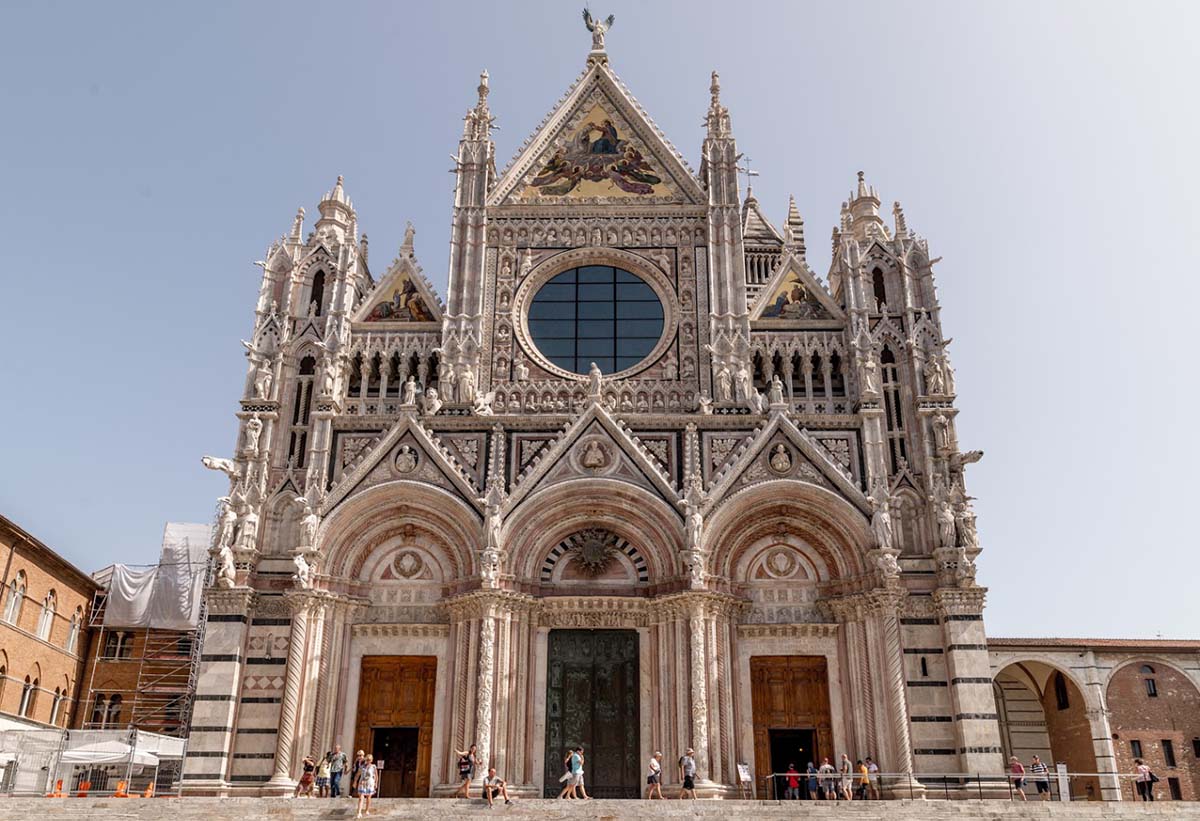
by Ron Ellege
What do some of Italy’s finest artists of the day, Nicola and Giovanni Pisano, Donatello, Pinturicchio, Lorenzo Ghiberti, and Bernini, have in common? They all contributed to one of the finest displays of Gothic architecture in Italy. Siena’s Cathedral of Santa Maria Assunta is filled with treasures by Pisano, Donatello and Michelangelo, as well as frescoes by Pinturicchio.
The Beginning
Begun in 1229, and the dome completed in 1264, Siena’s Cathedral is a spectacular edifice inside and out. With a vision of hosting the largest cathedral in Europe, the existing structure was to become the transept of a new cathedral more than 100 meters long. Tragically, their dream of an imposing cathedral died in 1348 when, within a few months, 60 percent of Siena’s inhabitants were struck down by the Black Plague.
The remnants of the outer walls remain today and bring perspective to the vision they had undertaken.
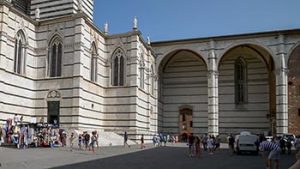 The west facade was begun in 1285 under the watchful eye of Giovanni Pisano. In 1296 Pisano hastily left the city over a creative dispute with the governing council and his work was completed 100 years later by Giovanni di Cecco.
The west facade was begun in 1285 under the watchful eye of Giovanni Pisano. In 1296 Pisano hastily left the city over a creative dispute with the governing council and his work was completed 100 years later by Giovanni di Cecco.
In the 19th century, the Cathedral was extensively restored and the golden mosaics in the upper gables were made by Venetian artists in the late 1870’s. The large central mosaic, the Coronation of the Virgin, is the work of Luigi Mussini. The Nativity of Jesus and Presentation of Mary in the Temple, were made by Alessandro Franchi. The large rose window is surrounded by busts of 36 patriarchs and a statue of the Madonna and Child.
Inside The Cathedral
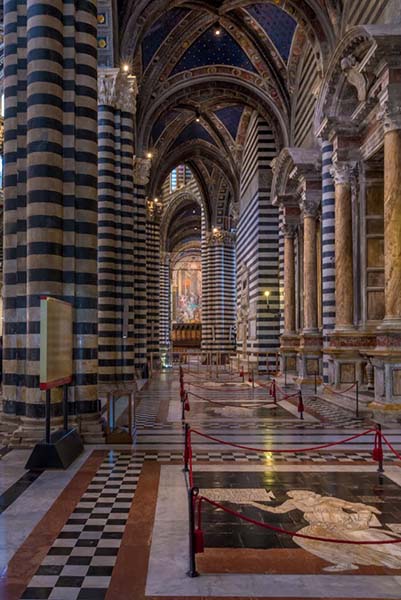 Prepare to be amazed as the Wow Factor will captivate your senses the moment you enter the doors of this historic Gothic Cathedral. The black and white marble stripes on the walls and columns immediately captivate the eye. Black and white is seen throughout Siena and are the city’s symbolic colors.
Prepare to be amazed as the Wow Factor will captivate your senses the moment you enter the doors of this historic Gothic Cathedral. The black and white marble stripes on the walls and columns immediately captivate the eye. Black and white is seen throughout Siena and are the city’s symbolic colors.
Stop at the visitor’s desk directly across from the entrance where you can pick up an audio tour which will take you on an informational journey through the highlights of the Cathedral.
While standing in the short line for your tour radio, glance up at the cornice that runs the length of the nave. It is decorated with busts of popes fashioned in the workshop of Giovanni di Stefano who began his work in 1495. Below are 36 busts of Roman and Byzantine emperors from Constantine to Theodosiu.
Located over the main doors in the west façade is one of two rose windows not to be missed. This beautiful oculus depicts the Last Supper and was created by Pastorino de’ Pastorini in 1549.
The Central Nave
Venturing into the Cathedral we observe the central nave.
Here we view the high altar flanked by columns topped by our first glimpse of the hexagonal dome which is topped with Bernini’s gilded lantern.
Under the dome are gold-plated stucco statues of Patron Saints of Siena sculpted by Ventura di Giuliano and Bastiano di Francesco in 1490.
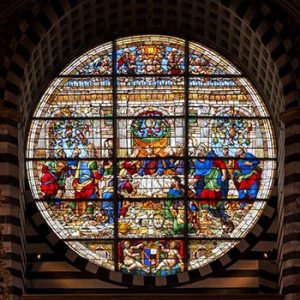 The Duccio Oculus, the round stained-glass window over the apse is one of the earliest existing examples of Italian stained glass.
The Duccio Oculus, the round stained-glass window over the apse is one of the earliest existing examples of Italian stained glass.
It depicts the assumption, burial and coronation of the Virgin Mary and was crafted by Duccio di Buoninsegna in 1288.
The Floors
As you stroll through this art filled Cathedral with astonishing sculptures, frescos, and relics on display in every quadrant, pay close attention to the floors. This composite of marble inlays which were crafted over six centuries (from the fourteenth to the nineteenth century), are covered for protection during much of the year. Plan on arriving between mid-August and late October if you wish to view them.
Of all the mosaic marble panels, I have two favorites. The large panel in the transept “The Slaughter of the Innocents”.
This is thought to be the work of Matteo di Giovanni in 1481. It is the only story coming from a Gospel, Matthew 2:13-23, all the other illustrations are based on the Old Testament and classical sources.
The earliest floor panel in the Cathedral is the Wheel of Fortune and the Sienese Wolf.
This panel, located close to the entrance, dates to sometime between 1369 and 1373.
Self-Portraits
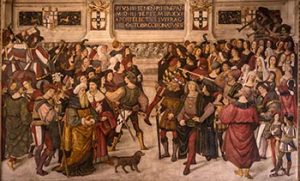 Above the entrance to the Piccolomini Library is this fresco of the papal coronation of Pius III by Bernardino di Betto (Pinturicchio).
Above the entrance to the Piccolomini Library is this fresco of the papal coronation of Pius III by Bernardino di Betto (Pinturicchio).
I love this fresco as it captures the nature of many of the artists of the time. Pinturicchio, as he often did during this period in his career, included a portrait of himself. Pinturicchio is standing facing us, he is the one in front of the crowd on your right while viewing this fresco.
Another self-portrait is an addition by Michelangelo to the Piccolomini Altarpiece.
This complex altarpiece was commissioned by cardinal Francesco Todeschini Piccolomini and built between 1481 and 1485 by Andrea Bregno. However, its prominence is more for the four sculptures in the lower niches. Saint Peter, Saint Paul, Saint Gregory, and Saint Pius were sculpted by Michelangelo between 1501 and 1504. The statue of St. Paul is a self-portrait of the young Michelangelo.
The Last Glimpse
As you proceed from the cathedral, south toward Piazza del Campo, be sure to look back for a view of the dome and bell tower through the arch in the south wall of Duomo Nuovo.
The dome rises from a hexagonal base with supporting columns. The lantern atop the dome was later added by Gian Lorenzo Bernini.
If You Go:
You can drive, but it may not be the best choice.
By Car:
Siena is one of Italy’s prominent hilltop-towns and is located a mere 76 kilometers south of the beautiful city of Florence. The drive takes only 45 minutes via the Autostrada, however, once you arrive in Siena you will find that you cannot enter the old town unless you are booked in a local hotel. Parking is difficult to find and will often be located beyond any reasonable walking distance.
Our favorite car rental in much of Europe and the world. www.rentalcars.com.
Train or bus may be your best option if you are not taking one of the many tours offered in Florence.
Our favorite tour company is Walks of Italy.
By Train:
Siena is about 90 minutes by train, and they are scheduled frequently throughout the day. The train station is located close to Siena’s many tourist attractions and is about one-and-a-half kilometers from the Cathedral.
When traveling by rail I have two sites I check with: Trainline and Vacations By Rail.
The SITA Bus provides numerous links from the city of Florence to Chianti, and is the best way to get easily to Siena. Using the Rapide (express) Bus it will take about an hour from Florence, and you gain the added advantage of being taken to the historic center of town, close to the Cathedral.
Be Aware:
As is the case in all of Italy, to enter a place of worship you must dress accordingly (women’s shoulders should be covered, shorts are not appropriate, and men must wear shirts). Food and drink is not allowed in the Cathedral so take advantage of one of the many cafes and restaurants located a few steps away.
The public is welcome and encouraged to attend weekday and Sunday masses, but no sightseeing is permitted during these events.
Cost and Hours:
Tickets are €6 per person while the marble pavement is uncovered, usually from mid-August to late October. The rest of the year, entrance is €3 per person.
Siena Cathedral (Santa Maria Assunta, or Most Holy Mary of the Assumption) is open from 10:30 a.m. to 7 p.m. on weekdays, and from 9:30 p.m. to 6 p.m. on Sundays and holidays.
About the author:
Ron Elledge is a Freelance Photographer/Writer who splits his time between Phoenix, Arizona and Albuquerque, New Mexico when not on a photo shoot or world adventure. Ron’s photography can be viewed at www.RonElledgePhotography.com. His love of travel is shared by his wife, Shelli, with whom he travels the globe and together they document their journeys.
All photos by Ron Elledge





Leave a Reply
You must be logged in to post a comment.